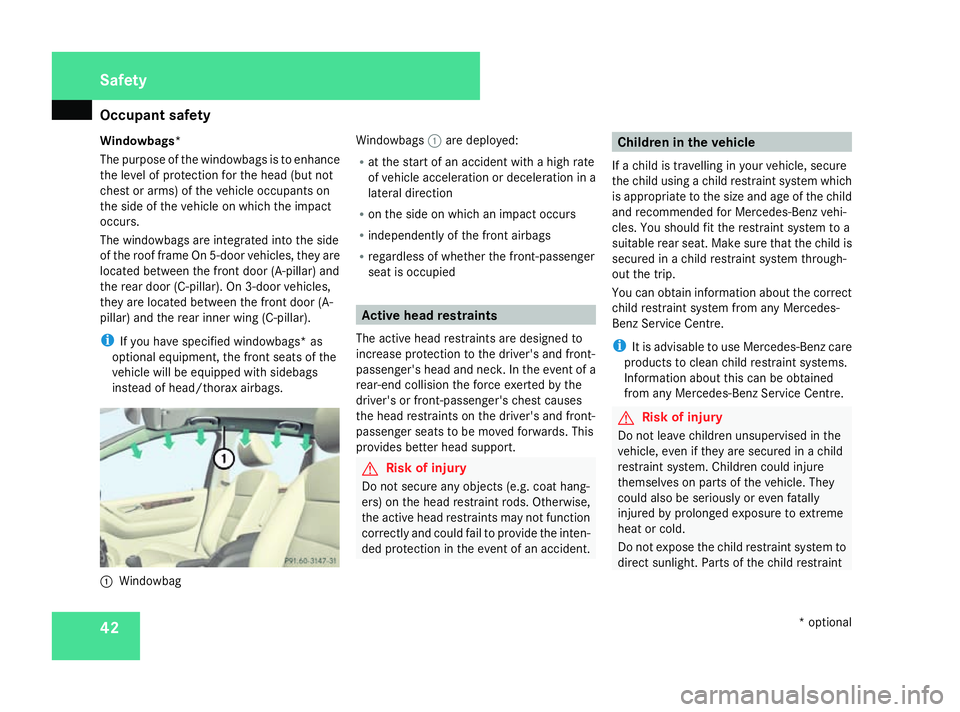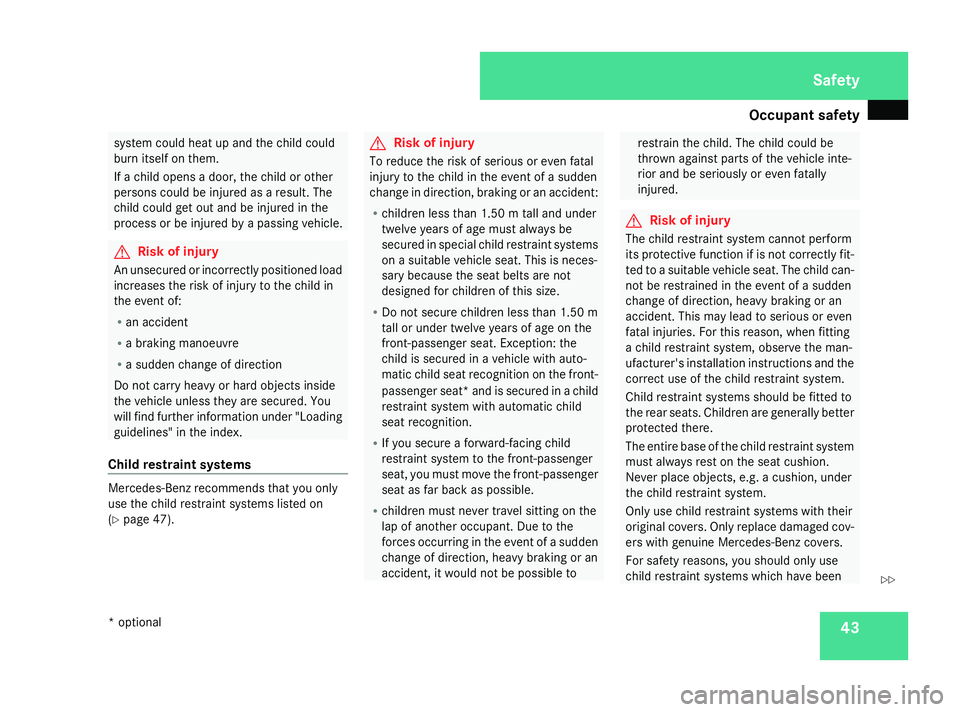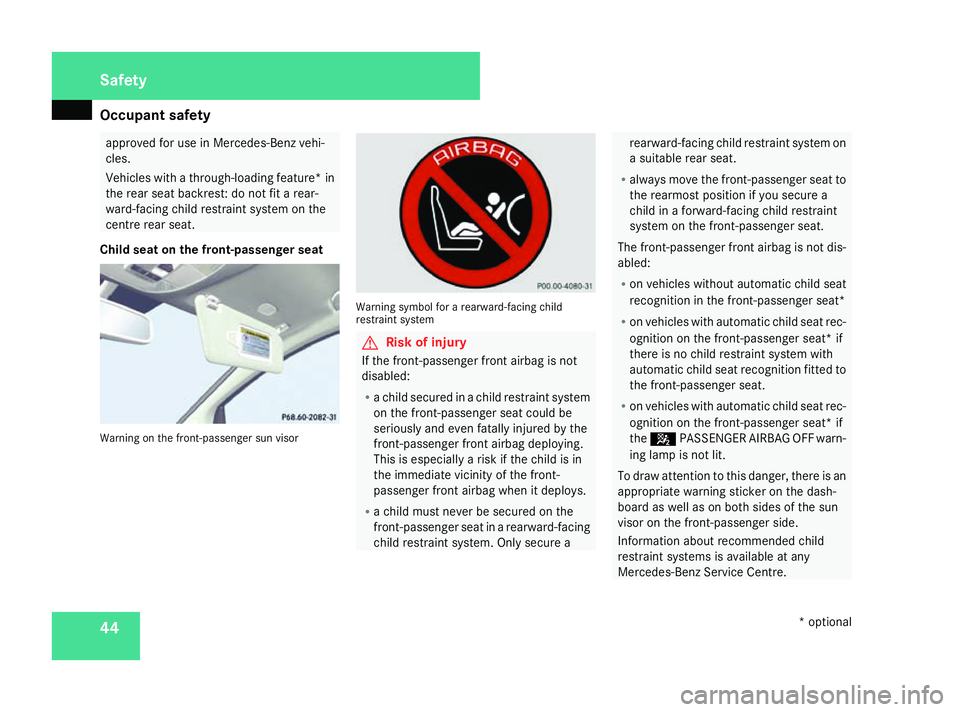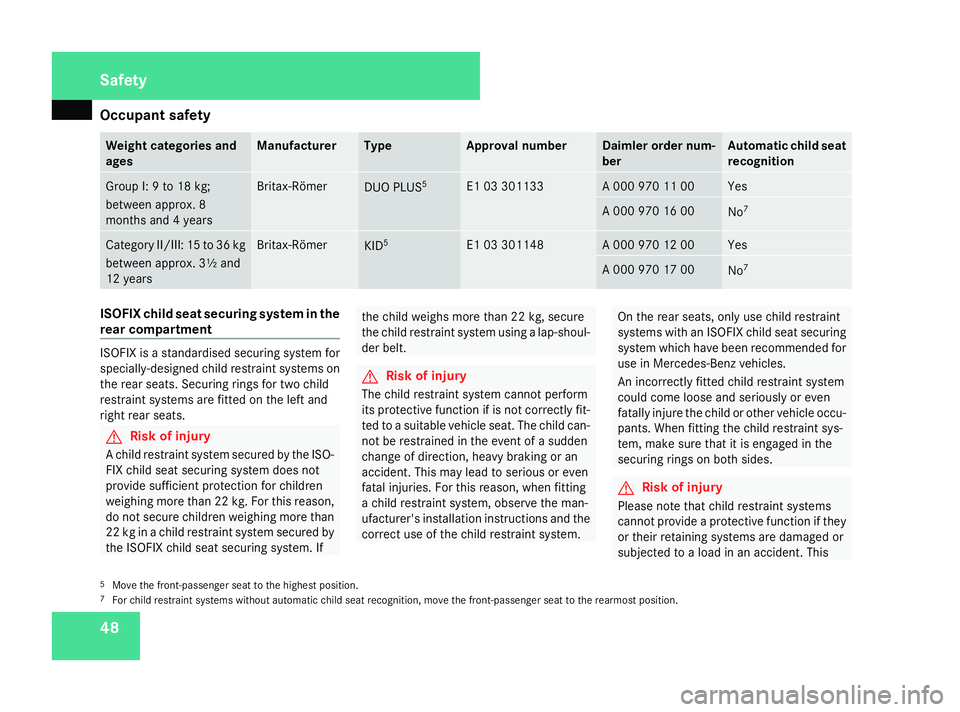2008 MERCEDES-BENZ A-CLASS HATCHBACK ECU
[x] Cancel search: ECUPage 11 of 305

8
Indicator lamps
see Warning and indicator lamps
Instrument cluster............................... 97
Overview. .......................................... 26
Selecting the language (on-board
computer). ...................................... 108
Instrument lighting.............................. 97
Integrated child seat............................ 50
Interior lighting Automatic control system .................82
Delayed switch-off (on-board
computer). ...................................... 110
Emergency lighting. ..........................83
Manual control.................................. 82
Reading lamp .................................... 82
Interior motion sensor......................... 58
ISOFIX child seat securing system..... 48J
Jack...................................................... 200 Operation........................................ 259
Jump-starting ...................................... 266
Jump leads ...................................... 266K
Key......................................................... 60 Changing the battery ......................244
Checking the battery ......................244
Display message ............................. 220Loss.
............................................... 239
Malfunction..................................... 239
Modifying the programming. .............60
Key positions
Key. .................................................. 62
Kickdown.............................................. 96 L
Lamps see Warning and indicator lamps
Lashing eyelets.................................. 146
Licence plate lighting Display message ............................. 218
Light bulbs
see Bulbs
Lighting
see Lights
Lights
Automatic headlamp mode. ..............78
Constant headlamp mode. ................78
Cornering light function ....................81
Dipped-beam headlamps ..................78
Display messages ........................... 216
Foglamps. ......................................... 79
Hazard warning lamps. .....................80
Headlamp flasher.............................. 80
Headlamp range. .............................. 80
Light switch. ..................................... 77
Main-beam headlamps..................... .80
Rear fog lamp ................................... 79Switching off (display message)...... 218
Turn signals.
..................................... 79
LIM indicator lamp
Cruise control. ................................ 116
Variable Speedtronic. .....................118
Load compartment load, maximum
..................................................... 288, 289
Loading guidelines............................. 145
Locking Automatic. ........................................ 61
Emergency locking .........................242
From the inside (central locking
button) .............................................. 61
Luggage compartment enlarge-
ment.................................................... 150
Luggage compartment floor Adjusting the height .......................155
stowage well, unde r........................ 154
Luggage cover.................................... 159
Luggage net........................................ 145
Lumbar support.................................... 68 M
Main-beam headlamps Display message ............................. 218
Main fuse box..................................... 271
Maintenance Battery ............................................ 263Index
169_AKB; 2; 4, en-GB
wdomann,
Version: 2.10.6
2008-07-16T08:52:06+02:00 - Seite 8 Dateiname: 6515_0315_02_buchblock.pdf; preflight
Page 14 of 305

11S
Seat Adjusting. ................................... 63, 65
Correct driver's seat position. ..........76
Folding the rear bench seat
forward. .......................................... 150
Removing/fitting the front-
passenger seat. .............................. 156
Removing/fitting the rear seat
backrest. ........................................ 152
Removing/fitting the rear seat
cushion. .......................................... 151
Seat belt
Adjusting the height.......................... 75
Display message .......................76, 212
Fastening. ......................................... 73
Warning lamp. .......................... 75, 228
Seat cushion
Removing (rear bench seat). ...........151
Seat heating......................................... .69
Seat ventilation Malfunction indicator lamp. ............222
Securing a load................................... 146
Selector lever Positions. .......................................... 94
Service indicator................................ 191
Service products................................ 292
Brake fluid. ..................................... 300Coolant.
.......................................... 297
Windscreen washer fluid. ................300
Settings
Factory (on-board computer). .........106
Setting the unit (on-board computer)
Speedometer. ................................. 108
Sidebags................................................ 41
Side window
Fault. .............................................. 238
Side windows
Cleaning. ........................................ 194
Opening/closing. .............................. 84
resetting ........................................... 85
Ski rack............................................... 144
Snow chains....................................... 182
Socket Cockpit. .......................................... 163
Luggage compartment. ...................164
Spare wheel
Fitting ............................................. 259
Storage location. ............................ 200
Technical data. ............................... 285
Speed
Technical data. ............................... 280
Speed limiter
Speedtronic. ................................... 117Speedometer
Digital speedometer (on-board
computer). ...................................... 103
Setting the unit (on-board com-
puter). ............................................. 108
Speedtronic ........................................ 117
Display message ............................. 220
Permanent. ..................................... 120
Variabl e.......................................... 118
SRS (Supplemental Restraint Sys-
tem)....................................................... 37
Display message ............................. 211
Warning lamp. .......................... 37, 226
Standard display (on-board com-
puter) ................................................... 103
Station see Radio
Status line (on-board computer)....... 100
Selecting the display....................... 108
Steering
Display message ............................. 215
Steering assistant STEER CONTROL ...56
Steering wheel Adjusting .......................................... 70
Buttons (on-board computer)............ 98
Stowage compartment...................... 159
Armrest (front) ................................ 160
Armrest (under) .............................. 161
Boxes under the driver's seat/
front-passenger seat....................... 161 Index
169_AKB; 2; 4, en-GB
wdomann,
Version: 2.10.6 2008-07-16T08:52:06+02:00 - Seite 11Dateiname: 6515_0315_02_buchblock.pdf; preflight
Page 42 of 305

Occupant safety
39Comply with safety regulations when dis-
posing of belt tensioners. Any Mercedes-
Benz Service Centre can provide details of
these regulations.
Airbags Airbag deployment slows down and restricts
the movement of the vehicle occupant.
If the airbags are deployed, you will hear a
bang and a small amount of powder may also
be released. Only in rare cases will the bang
affect your hearing. The powder that escapes
does not generally constitute a health hazard.
The
1 warning lamp lights up.
The SRS/AIRBAG identification indicates the
location of the airbags. G
Risk of injury
Airbags provide additional protection; they
are not, however, a substitute for seat
belts.
Observe the following notes to reduce the
risk of serious or even fatal injury if an air-
bag is deployed:
R all vehicle occupants — in particular preg-
nant women — must wear their seat belt
correctly at all times and lean back against the backrest, which should be
positioned as close to the vertical as pos-
sible. The head restraint must support
the back of the head at about eye level.
R always secure children less than 1.50 m
tall or under 12 years of age in suitable
child restraint systems.
R all vehicle occupants must select a seat
position that is as far away from the air-
bag as possible. The driver's seat posi-
tion must allow the vehicle to be driven
safely. The driver's chest should be as far
away from the middle of the driver's front
airbag cover as possible.
R move the front-passenger seat as far
back as possible, especially if a child is
secured in a child restraint system on the
seat.
R vehicle occupants – in particular, chil-
dren – must not lean their head on the
area of the window in which a sidebag or
head/thorax airbag* is deployed.
R Rearward-facing child restraint systems
must not be fitted to the front-passenger
seat unless the front-passenger front air-
bag has been disabled. The front-
passenger front airbag of a vehicle fitted with automatic child seat recognition* is
only disabled when a child restraint sys-
tem with automatic child seat recogni-
tion is fitted to the front-passenger seat.
The
5 PASSENGER AIRBAG OFF
warning lamp must be constantly lit.
If the front-passenger seat of your vehicle
does not have automatic child seat rec-
ognition*, or your rearward-facing child
restraint system does not have such a
feature, children must be secured in a
child restraint system on a suitable seat
in the rear. If you secure a forward-facing
child restraint system to the front-
passenger seat, you must move the front-
passenger seat as far back as possible.
R make sure there are no heavy or sharp-
edged objects in pockets of clothing.
R do not lean forwards, e.g. over the cover
of the driver's front airbag, particularly
when the vehicle is in motion.
R do not put your feet on the dashboard.
R only hold the steering wheel by the rim.
This allows the airbag to inflate fully. You
could be injured if the airbag is deployed
and you are holding the inside of the
steering wheel. Safety
* optional
169_AKB; 2; 4, en-GB
wdomann
,V ersion: 2.10.6
2008-07-16T08:52:06+02:00 - Seite 39 ZDateiname: 6515_0315_02_buchblock.pdf; preflight
Page 45 of 305

Occupant safety
42
Windowbags*
The purpose of the windowbags is to enhance
the level of protection for the head (but not
chest or arms) of the vehicle occupants on
the side of the vehicle on which the impact
occurs.
The windowbags are integrated into the side
of the roof frame On 5-door vehicles, they are
located between the front door (A-pillar) and
the rear door (C-pillar). On 3-door vehicles,
they are located between the front door (A-
pillar) and the rear inner wing (C-pillar).
i If you have specified windowbags* as
optional equipment, the front seats of the
vehicle will be equipped with sidebags
instead of head/thorax airbags. 1
Windowbag Windowbags
1are deployed:
R at the start of an accident with a high rate
of vehicle acceleration or deceleration in a
lateral direction
R on the side on which an impact occurs
R independently of the front airbags
R regardless of whether the front-passenger
seat is occupied Active head restraints
The active head restraints are designed to
increase protection to the driver's and front-
passenger's head and neck. In the event of a
rear-end collision the force exerted by the
driver's or front-passenger's chest causes
the head restraints on the driver's and front-
passenger seats to be moved forwards. This
provides better head support. G
Risk of injury
Do not secure any objects (e.g. coat hang-
ers) on the head restraint rods. Otherwise,
the active head restraints may not function
correctly and could fail to provide the inten-
ded protection in the event of an accident. Children in the vehicle
If a child is travelling in your vehicle, secure
the child using a child restraint system which
is appropriate to the size and age of the child
and recommended for Mercedes-Benz vehi-
cles. You should fit the restraint system to a
suitable rear seat. Make sure that the child is
secured in a child restraint system through-
out the trip.
You can obtain information about the correct
child restraint system from any Mercedes-
Benz Service Centre.
i It is advisable to use Mercedes-Benz care
products to clean child restraint systems.
Information about this can be obtained
from any Mercedes-Benz Service Centre. G
Risk of injury
Do not leave children unsupervised in the
vehicle, even if they are secured in a child
restraint system. Children could injure
themselves on parts of the vehicle. They
could also be seriously or even fatally
injured by prolonged exposure to extreme
heat or cold.
Do not expose the child restraint system to
direct sunlight. Parts of the child restraint Safety
* optional
169_AKB; 2; 4, en-GB
wdomann,
Version: 2.10.6
2008-07-16T08:52:06+02:00 - Seite 42 Dateiname: 6515_0315_02_buchblock.pdf; preflight
Page 46 of 305

Occupant safety
43system could heat up and the child could
burn itself on them.
If a child opens a door, the child or other
persons could be injured as a result. The
child could get out and be injured in the
process or be injured by a passing vehicle.
G
Risk of injury
An unsecured or incorrectly positioned load
increases the risk of injury to the child in
the event of:
R an accident
R a braking manoeuvre
R a sudden change of direction
Do not carry heavy or hard objects inside
the vehicle unless they are secured. You
will find further information under "Loading
guidelines" in the index.
Child restraint systems Mercedes-Benz recommends that you only
use the child restraint systems listed on
(Y page 47). G
Risk of injury
To reduce the risk of serious or even fatal
injury to the child in the event of a sudden
change in direction, braking or an accident:
R children less than 1.50 m tall and under
twelve years of age must always be
secured in special child restraint systems
on a suitable vehicle seat. This is neces-
sary because the seat belts are not
designed for children of this size.
R Do not secure children less than 1.50 m
tall or under twelve years of age on the
front-passenger seat. Exception: the
child is secured in a vehicle with auto-
matic child seat recognition on the front-
passenger seat* and is secured in a child
restraint system with automatic child
seat recognition.
R If you secure a forward-facing child
restraint system to the front-passenger
seat, you must move the front-passenger
seat as far back as possible.
R children must never travel sitting on the
lap of another occupant. Due to the
forces occurring in the event of a sudden
change of direction, heavy braking or an
accident, it would not be possible to restrain the child. The child could be
thrown against parts of the vehicle inte-
rior and be seriously or even fatally
injured.
G
Risk of injury
The child restraint system cannot perform
its protective function if is not correctly fit-
ted to a suitable vehicle seat. The child can-
not be restrained in the event of a sudden
change of direction, heavy braking or an
accident. This may lead to serious or even
fatal injuries. For this reason, when fitting
a child restraint system, observe the man-
ufacturer's installation instructions and the
correct use of the child restraint system.
Child restraint systems should be fitted to
the rear seats. Children are generally better
protected there.
The entire base of the child restraint system
must always rest on the seat cushion.
Never place objects, e.g. a cushion, under
the child restraint system.
Only use child restraint systems with their
original covers. Only replace damaged cov-
ers with genuine Mercedes-Benz covers.
For safety reasons, you should only use
child restraint systems which have been Safety
* optional
169_AKB; 2; 4, en-GB
wdomann
,V ersion: 2.10.6
2008-07-16T08:52:06+02:00 - Seite 43 ZDateiname: 6515_0315_02_buchblock.pdf; preflight
Page 47 of 305

Occupant safety
44 approved for use in Mercedes-Benz vehi-
cles.
Vehicles with a through-loading feature* in
the rear seat backrest: do not fit a rear-
ward-facing child restraint system on the
centre rear seat.
Child seat on the front-passenger seat Warning on the front-passenger sun visor Warning symbol for a rearward-facing child
restraint system
G
Risk of injury
If the front-passenger front airbag is not
disabled:
R a child secured in a child restraint system
on the front-passenger seat could be
seriously and even fatally injured by the
front-passenger front airbag deploying.
This is especially a risk if the child is in
the immediate vicinity of the front-
passenger front airbag when it deploys.
R a child must never be secured on the
front-passenger seat in a rearward-facing
child restraint system. Only secure a rearward-facing child restraint system on
a suitable rear seat.
R always move the front-passenger seat to
the rearmost position if you secure a
child in a forward-facing child restraint
system on the front-passenger seat.
The front-passenger front airbag is not dis-
abled:
R on vehicles without automatic child seat
recognition in the front-passenger seat*
R on vehicles with automatic child seat rec-
ognition on the front-passenger seat* if
there is no child restraint system with
automatic child seat recognition fitted to
the front-passenger seat.
R on vehicles with automatic child seat rec-
ognition on the front-passenger seat* if
the 5 PASSENGER AIRBAG OFF warn-
ing lamp is not lit.
To draw attention to this danger, there is an
appropriate warning sticker on the dash-
board as well as on both sides of the sun
visor on the front-passenger side.
Information about recommended child
restraint systems is available at any
Mercedes-Benz Service Centre. Safety
* optional
169_AKB; 2; 4, en-GB
wdomann,
Version: 2.10.6
2008-07-16T08:52:06+02:00 - Seite 44 Dateiname: 6515_0315_02_buchblock.pdf; preflight
Page 51 of 305

Occupant safety
48 Weight categories and
ages Manufacturer Type Approval number Daimler order num-
ber Automatic child seat
recognition
Group I: 9 to 18 kg;
between approx. 8
months and 4 years Britax-Römer
DUO PLUS
5 E1 03 301133 A 000 970 11 00 Yes
A 000 970 16 00
No
7 Category II/III: 15 to 36 kg
between approx. 3½ and
12 years Britax-Römer
KID
5 E1 03 301148 A 000 970 12 00 Yes
A 000 970 17 00
No
7 ISOFIX child seat securing system in the
rear compartment
ISOFIX is a standardised securing system for
specially-designed child restraint systems on
the rear seats. Securing rings for two child
restraint systems are fitted on the left and
right rear seats. G
Risk of injury
A child restraint system secured by the ISO-
FIX child seat securing system does not
provide sufficient protection for children
weighing more than 22 kg. For this reason,
do not secure children weighing more than
22 kg in a child restraint system secured by
the ISOFIX child seat securing system. If the child weighs more than 22 kg, secure
the child restraint system using a lap-shoul-
der belt. G
Risk of injury
The child restraint system cannot perform
its protective function if is not correctly fit-
ted to a suitable vehicle seat. The child can-
not be restrained in the event of a sudden
change of direction, heavy braking or an
accident. This may lead to serious or even
fatal injuries. For this reason, when fitting
a child restraint system, observe the man-
ufacturer's installation instructions and the
correct use of the child restraint system. On the rear seats, only use child restraint
systems with an ISOFIX child seat securing
system which have been recommended for
use in Mercedes-Benz vehicles.
An incorrectly fitted child restraint system
could come loose and seriously or even
fatally injure the child or other vehicle occu-
pants. When fitting the child restraint sys-
tem, make sure that it is engaged in the
securing rings on both sides.
G
Risk of injury
Please note that child restraint systems
cannot provide a protective function if they
or their retaining systems are damaged or
subjected to a load in an accident. This
5 Move the front-passenger seat to the highest position.
7 For child restraint systems without automatic child seat recognition, move the front-passenger seat to the rearmost position. Safety
169_AKB; 2; 4, en-GB
wdomann
,V ersion: 2.10.6
2008-07-16T08:52:06+02:00 - Seite 48 Dateiname: 6515_0315_02_buchblock.pdf; preflight
Page 52 of 305

Occupant safety
49could result in serious or even fatal injuries
to the secured child in the event of an acci-
dent, heavy braking or a sudden change in
direction.
For this reason, have child restraint sys-
tems and their anchorages which have
been damaged or subjected to a load in an
accident checked immediately at a quali-
fied specialist workshop.
! When fitting the child restraint system,
make sure that the seat belt for the middle
seat does not become trapped. It could
otherwise be damaged. 1
Securing rings TopTether
TopTether provides an additional connection
between the child restraint system secured
with ISOFIX and the front-passenger seat. It
helps reduce the risk of injury even further.
Both TopTether anchorages are attached to
the rear of the rear seat backrests.
1
Head restraints
2 Rear seat backrests
3 Luggage compartment cover*
4 TopTether anchorages 4
TopTether anchorage
5 TopTether hook*
6 TopTether belt* for the ISOFIX child
restraint system
X Move head restraint 1upwards.
X Vehicles with a luggage compartment
cover*: release rear seat backrest 2
(Y page 150) and fold it forwards slightly.
X All: guide TopTether belt* 6under head
restraint 1between the two head restraint
rods.
X Fit TopTether hook* 5into TopTether
anchorage 4on the back of rear seat
backrest 2. Safety
* optional
169_AKB; 2; 4, en-GB
wdomann,
Version: 2.10.6 2008-07-16T08:52:06+02:00 - Seite 49 ZDateiname: 6515_0315_02_buchblock.pdf; preflight